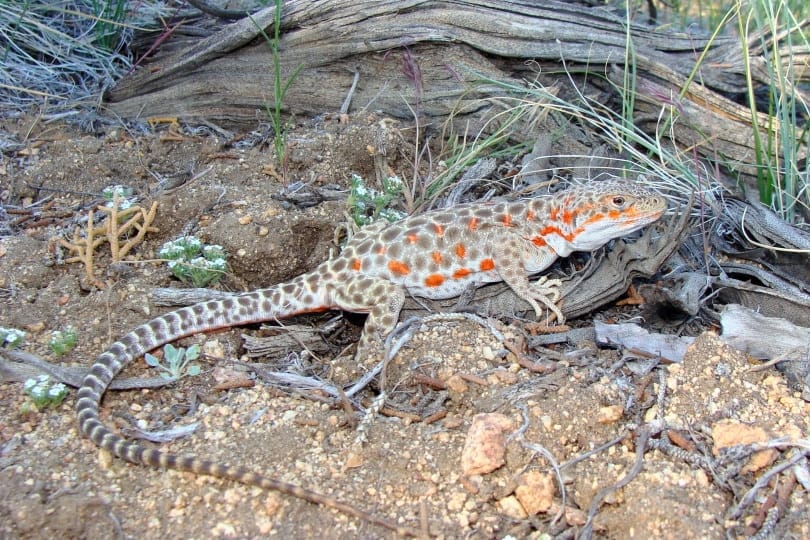Lizards are fun and interesting little animals, and unlike other reptiles, they’re not likely to bite you or inject you with life-threatening venom (though that’s not always the case!). It’s understandable if you get excited when one of these little creatures crosses your path.
If you live in California, lizards will likely be crossing your path quite often. There are dozens of different species that call the state home, including a few invasive ones, and they can be found in every environment, from the big city to the harsh desert.
This list will help you quickly identify just what kind of lizard you’re dealing with, as well as fill you in on a few of the wonderful varieties that share the Golden State with us.

The 10 Lizards Found in California
1. Banded Gila Monster

| Species: | H. suspectum cinctum |
| Longevity: | 35 years |
| Good to own as a pet?: | No |
| Legal to own?: | No |
| Adult size: | 9–14 inches |
| Diet: | Carnivorous |
The Banded Gila Monster is first on this list even though they’re not the most common. In fact, they’re actually quite rare and can only be found in the southwest part of the state in unforgiving desert areas. But this is the only poisonous lizard in California (or the entire United States, for that matter). It’s also one of the few big lizards in California.
Gila monster venom is no joke and can have serious effects on humans, the most notable of which is extreme and lasting pain. However, while it’s possible to die from a Gila monster bite, it’s rare and hasn’t happened for over a century. Basically, to die from a Gila monster bite, you need to be very old, very young, or very sick, and you also need to refuse to seek out medical attention.
They usually only emerge at dawn or dusk, especially after a rain. They’re slow and placid, so it’s not like they’ll attack you unprovoked. These lizards eat small mammals, insects, other reptiles, and eggs, and they can store fat in their tails, so they don’t need to eat that often. Not many other animals will try to eat them, although they sometimes get snacked on by coyotes and birds of prey.
2. Western Fence Lizard

| Species: | S. occidentalis |
| Longevity: | 6 years |
| Good to own as a pet?: | Yes |
| Legal to own?: | Yes |
| Adult size: | 4–8 inches |
| Diet: | Carnivorous |
This is the most common lizard in California. The Western fence lizard lives in various habitats, although they’re most often seen on farms and in other agricultural areas. The only places that they really avoid are extreme elevations and harsh deserts.
They have a blue stomach, which is why they’ve earned the moniker “blue-belly lizard”.
These reptiles like to sun themselves on rocks, pathways, and fences, which makes them easy targets for birds and other predators. However, they have lightning-fast reflexes, so they’re harder to snag than you might think. While up on those fence posts, they will eat mosquitoes, beetles, grasshoppers, and other bugs. They also eat ticks, and studies have shown that Lyme disease is less prevalent in areas where these creatures are common.
3. Southern Alligator Lizard
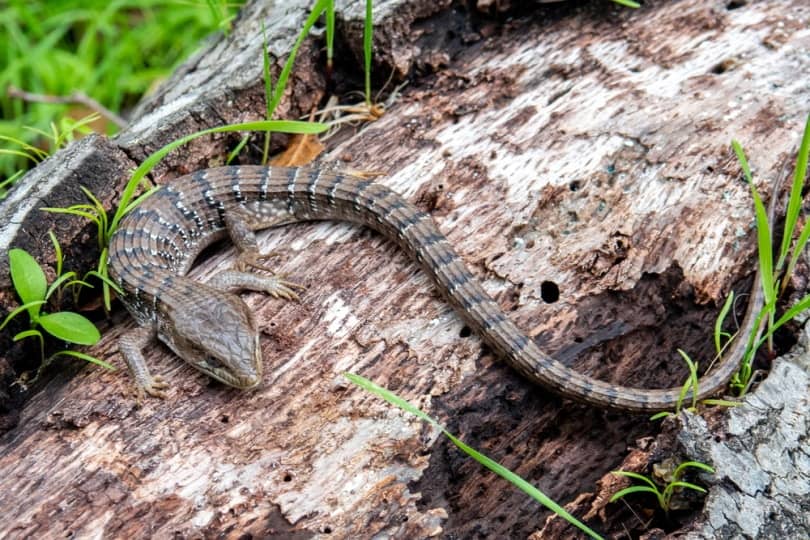
| Species: | E. multicarinata |
| Longevity: | 15 years |
| Good to own as a pet?: | Yes |
| Legal to own?: | Yes |
| Adult size: | 3–7 inches |
| Diet: | Carnivorous |
While there are fewer southern alligator lizards than western fence lizards in terms of sheer numbers, many Californians may be more likely to encounter this species because they’re incredibly common in urban areas. They especially like to hang out in areas where there’s water around.
Their scaly bodies look like snake bodies, and they have snake-like heads too. Despite their snake-like appearance, they have earned the name “alligator lizard”.
They eat just about anything smaller than they are, including the western fence lizard. They’ve also been known to eat birds and eggs, if they can. Snakes, bobcats, hawks, and coyotes will munch on one of these creatures if given a chance, but like many lizards, they can ditch their tails in a time of crisis.
4. Common Side-Blotched Lizard
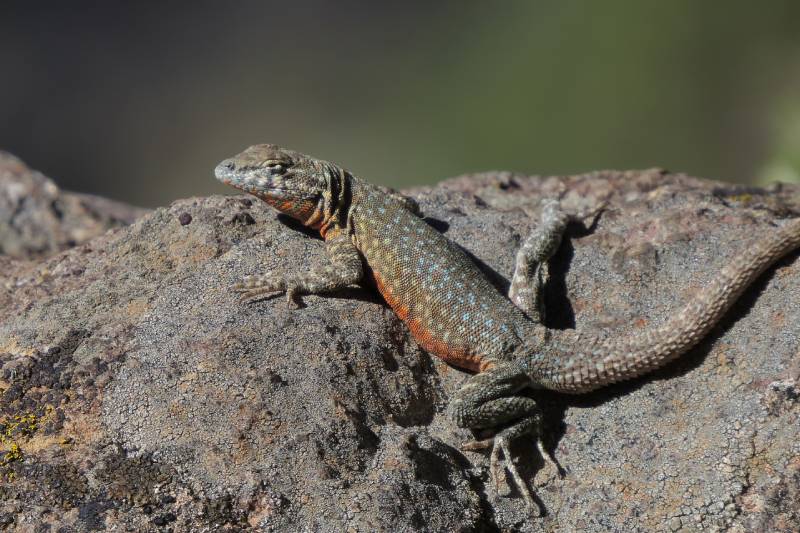
| Species: | U. stansburiana |
| Longevity: | 6 years |
| Good to own as a pet?: | Yes |
| Legal to own?: | Yes |
| Adult size: | 2–4 inches |
| Diet: | Carnivorous |
Just by knowing the name of this lizard, you’ll have a pretty good idea of how they look. These lizards have flecks of color running down their sides, although it’s predominantly the males that have this coloring, as females are more likely to be plain brown.
There are actually three different “morphs” of males, all of which are based on the animal’s throat. Those with orange throats are “ultra-dominant,” and they keep harems of females. Blue-throated lizards are simply dominant and they only get one lady. The yellow-throated males, however, are “sneakers”, which means they pretend to be females, and then when an ultra-dominant orange-throated male tries to add them to his harem, they mate with all his females.
These small lizards are found throughout California, although they’re more common in the southern areas.
5. San Diegan Legless Lizard
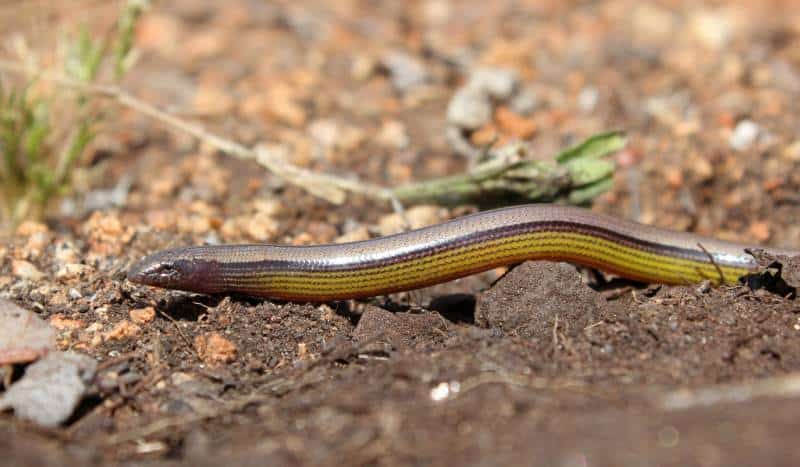
| Species: | A. stebbinsi |
| Longevity: | 20 years |
| Good to own as a pet?: | No |
| Legal to own?: | Yes |
| Adult size: | 7-–8 inches |
| Diet: | Carnivorous |
A legless lizard sounds like they should be a snake. However, herpetologists clarify that the difference is that these animals have eyelids, whereas snakes do not.
As the name implies, these lizards are found in the southern part of the state, near San Diego. However, they can live in various habitats within that geographical region, as they’re found near the coast and in the desert in nearly equal amounts.
That’s probably because they mainly stay underground, burrowing tunnels under the sand and looking for food like termites, spiders, and bug larvae. Their biggest predators are snakes, mice, weasels, birds, and domestic cats.
6. Baja California Collared Lizard

| Species: | C. vestigium |
| Longevity: | 8 years |
| Good to own as a pet?: | No |
| Legal to own?: | Yes |
| Adult size: | 2–4 inches |
| Diet: | Carnivorous |
Another small California lizard, this species has a large head with black bands that run across their body, like a collar. The banding is even more prominent on juveniles than on adults.
Many residents of the state will go their entire lives without ever seeing one of these lizards, but that doesn’t mean they’re not common—it just means they don’t prefer to hang around people. They live in rocky areas and washes, so they can be found in deserts and canyons, although they’re easier to find in the south.
They’ll eat all sorts of bugs, including grasshoppers and crickets, but other lizards make up a big portion of their diets. They’re even cannibalistic if given the chance. Conversely, they have to run for their lives if a roadrunner, coyote, or house cat is around.
7. Long-Nosed Leopard Lizard

| Species: | G. wislizenii |
| Longevity: | 7 years |
| Good to own as a pet?: | Yes |
| Legal to own?: | Yes |
| Adult size: | 3–5 inches |
| Diet: | Carnivorous |
There are several varieties of leopard lizards in California, but the long-nosed leopard is the most common of the bunch (many other species are actually endangered). These reptiles can be several different colors, including cream and gray, and they either have dark spots or bars across their backs. Unlike their cat namesakes, though, these leopards can change their spots, as both males and females will change colors during mating season.
They like flat surfaces like plains and gravel lots, and they prefer areas with little vegetation, as this gives them plenty of direct sunlight to bask in. They’ll eat bugs, but their biggest food source is other lizards. They’ll even eat small rodents if they can, as their long nose lets them munch on all sorts of animals. Sadly, though, many of these lizards have been found dead with an animal that was too big for them to swallow still clutched in their jaws.
8. Western Banded Gecko

| Species: | C. variegatus |
| Longevity: | 8 years |
| Good to own as a pet?: | Yes |
| Legal to own?: | Yes |
| Adult size: | 4–6 inches |
| Diet: | Carnivorous |
Western banded geckos are common throughout the desert regions of California, and they’re incredibly popular as pets. However, they’re illegal to collect and sell in virtually every state other than Nevada. Like long-nosed leopard lizards, they prefer areas with sparse vegetation, but they’re more likely to hang around urban environments.
These little creatures love to eat bugs, and they have a special fondness for arachnids, so both spiders and scorpions should live in fear when they’re around. They especially love to snack on baby scorpions.
They apparently learn from scorpions while eating them, as they’ll curl their tails over their bodies like a scorpion when threatened. This can fool potential predators into thinking that they’re venomous.
9. Common Chuckwalla
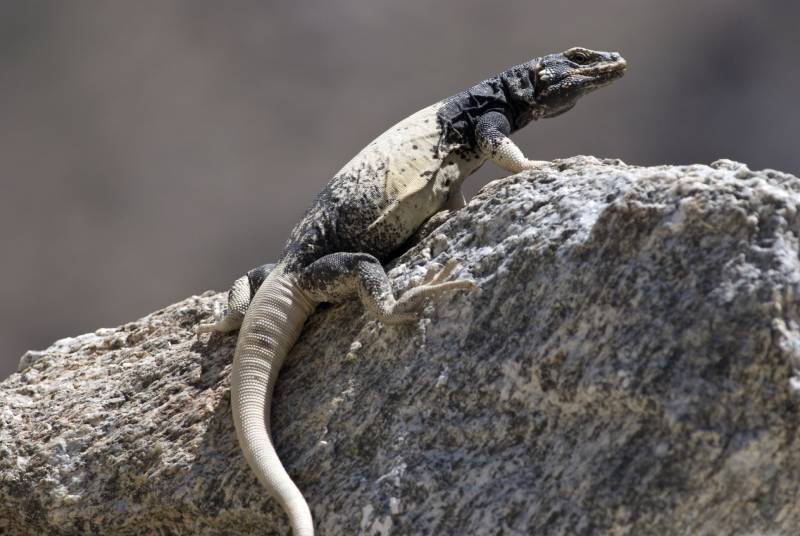
| Species: | S. ater |
| Longevity: | 25 years |
| Good to own as a pet?: | Yes |
| Legal to own?: | Yes |
| Adult size: | 15–20 inches |
| Diet: | Omnivorous |
Chuckwallas are big critters, and they’re one of the largest lizard species in California. They’re a desert-dwelling creature and are found mostly in the Sonoran and Mojave deserts. They apparently prefer lava flows and drought-tolerant scrub. Unlike most desert lizards, they’re active during the day throughout most of the year.
They have a stocky build with a potbelly, and they have thick, blunt-tipped tails. They’re primarily herbivores, and they like to eat leaves and fruits, but they’ll happily snatch up an insect if one wanders by.
Chuckwallas don’t have as many predators as other lizards, although it’s likely that some snakes and coyotes will eat them if given the chance. Their eggs are vulnerable to predation, though, and females will rarely leave a clutch for this reason.
10. Desert Horned Lizard
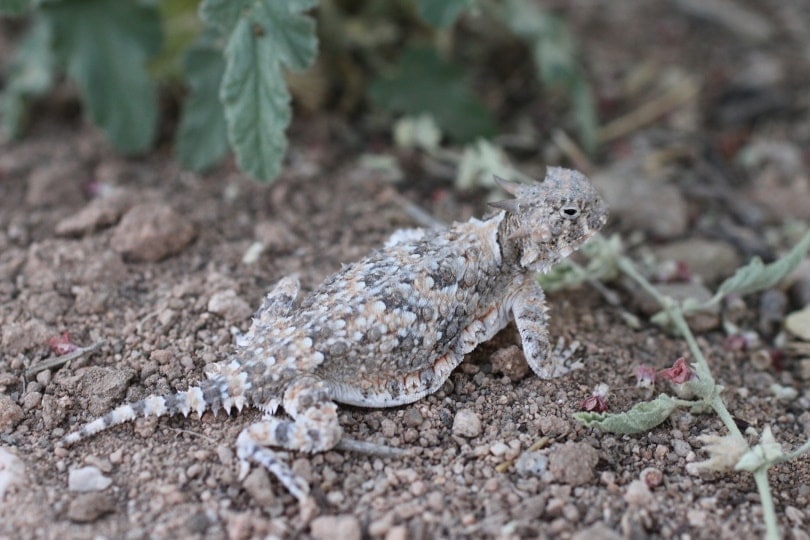
| Species: | P. platyrhinos |
| Longevity: | 8 years |
| Good to own as a pet?: | Yes |
| Legal to own?: | Yes |
| Adult size: | 2–4 inches |
| Diet: | Carnivorous |
Two things make this lizard notable: They have large, pointed scales, including a horn that sticks out the back of their heads, and they can shoot blood out of their eyes when threatened. As if that’s not wild enough, the blood jets can travel up to 5 feet away from the lizard!
They live in unforgiving desert environments, and they’ve been seen demonstrating rain-harvesting behavior. When it rains, these lizards will take on a specific posture that allows them to soak up as much water as possible.
These lizards primarily eat insects, and they love to hang out near anthills in order to thin the herds a little bit. Ants are low in nutrition, though, so they have to eat a massive amount of the little insects; as a result, desert horned lizards can expand their stomachs to hold all those ants.
Snakes, hawks, coyotes, squirrels, and cats will all eat these lizards, since apparently, they’re not put off by getting shot with a stream of eye-blood.

Final Thoughts
If you’re in California and you see a lizard in your immediate vicinity, chances are that it’s one of the species on this list. The variety of lizards in the state is huge, though, as you have everything from venomous Gila monsters to giant chuckwallas and everything in between.
However, they all have one thing in common: they want you to leave them alone. Take photos, not them as pets!
Featured Image Credit: Matt Jeppson, Shutterstock
